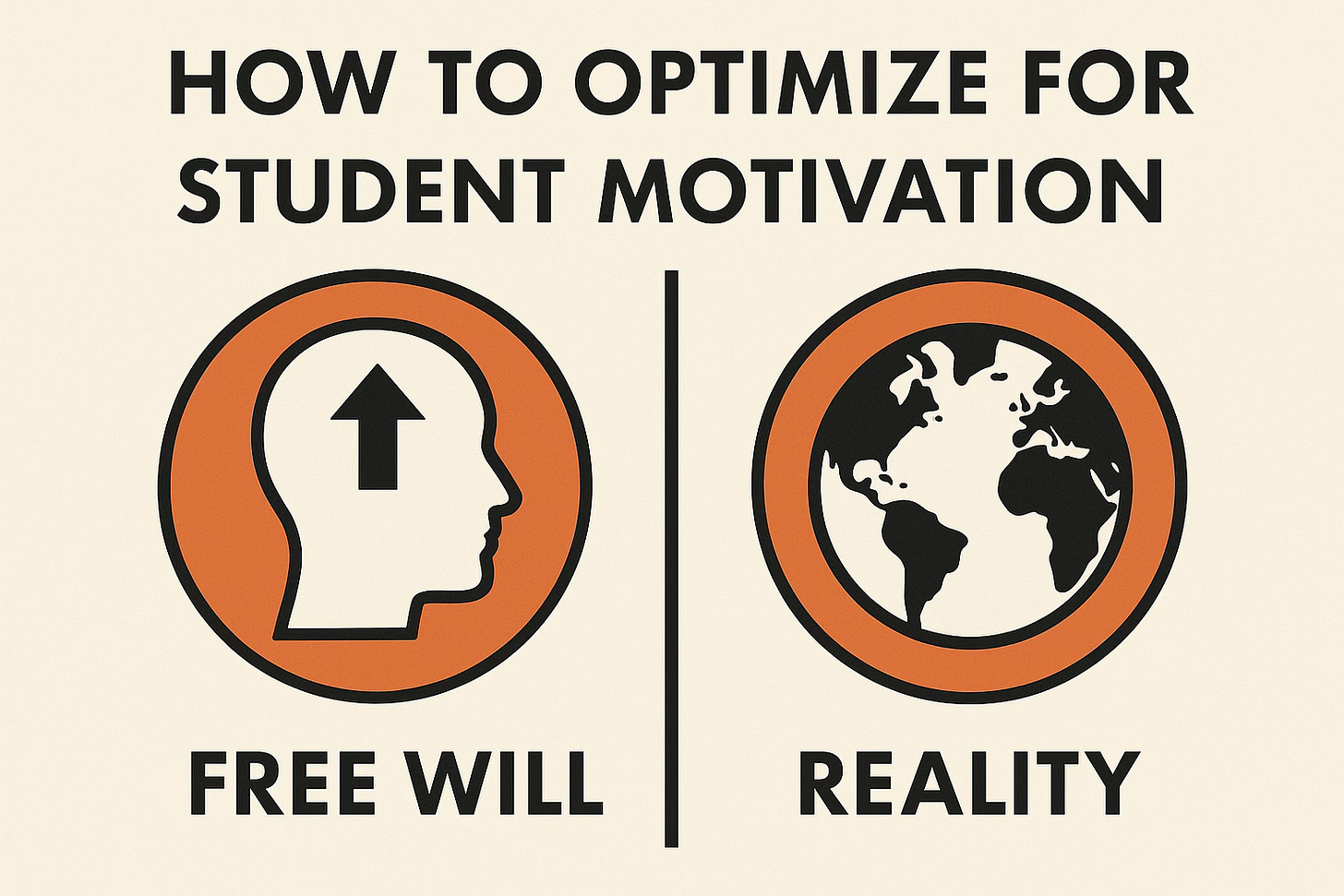#6 How to Optimize for Student Motivation
My last article was about helping students to adhere to reality by means of controlling error. This approach belongs to both of the high-structure models on the pedagogical spectrum. However, only the high-structure/high-freedom model affirms both the absolutism of reality AND the absolutism of free will.
It’s true that the fundamental task of education is for children to grasp reality—but, they must do it on their own. Their autonomy is absolute—just as absolute as reality itself. No human can think for another. Each child must—by metaphysical fact—grasp reality by and for himself.
Premise #2: Free Will
Humans have free will. Our futures are not determined by genetics, biology, environment, or a supernatural power. We each control our own destiny—our choices determine our future.
Genetics, biology, brain chemistry, and the child’s early environment can have a profound influence on a child’s life, shaping it in many ways—nevertheless, free will remains untouched (with rare exception), and the child’s own choices remain the dominant factor shaping his future.
Since children are free–by metaphysical fact–then they ought to be free in educational practice.
Maria Montessori speaks of the liberty of the child as a fundamental pedagogical principle: “Liberty is the experimental condition for studying the phenomenon of the child’s attention” (Advanced Montessori Method 1).
At the elementary level, Montessori writes that children “must be free to take what they need from their environment and not be questioned in their choice” (To Education the Human Potential).
To innovate in education, freedom is a necessary precondition. As Montessori put it, it’s a necessary “experimental condition” of scientific pedagogy.
Practice #2: Optimizing for Motivation
By giving children freedom, we are able to optimize curriculum and instruction for motivation. We are able to observe which subjects, presented in which ways, are most attractive to which students.
We can then experiment by modifying the curriculum material, modifying the method of presentation, modifying classroom routines or systems, etc. to optimize the students’ attraction to the content.
However, we can’t forget that the primary aim of education is to help the child to grasp reality. This means that we can’t just add bells and whistles to activities to attract the students. We must attract them by means of the educational content itself. We have to attract them into concentrated activity by which they grasp reality.
This can only be done experimentally, and it varies per child.
Let’s take, as an example, Observational Astronomy with 3rd and 4th graders:
The steps in educational innovation are: (1) Hypothesis, (2) Experimentation, (3) Observation
My first hypothesis was that children would be more attracted to astronomy if presented with the patterns of the celestial bodies as opposed to an abstract model of the solar system.
My first experiment was to simply let them explore with a digital planetarium called Stellarium.
I observed that they were attracted to it, but that there was not enough structure to lead them to the kind of discoveries which can truly sustain motivation.
My next hypothesis was that they might like to follow written lessons, guiding them towards various discoveries
I created one unit of lessons on the motion of the sun, another on the motion of the moon, and another on the motion of the five nearest planets.
Some students liked this, but not others. The ones who liked it were the most literate students in the class.
My next hypothesis was that verbal lessons might work better than written ones.
I gave individual and small group lessons on the various units I had created.
Again, some students had some interest, but I knew I could do better
Next, I thought that recording the lessons to allow independent access might be better.
I created videos for the lessons in one unit.
This did not work much better.
Then I thought that perhaps they just wanted “challenge” questions.
I gave students various challenge questions for them to try to answer using Stellarium
This got the most attraction from the most students so far.
Finally, I thought that I might want to organize these “challenges” for independent access.
I made a set of “Stellarium Challenge Cards”, organized in three levels of difficulty, for the students to independently access and use Stellarium to try to solve the challenges.
In the end, this turned out to attract almost all of the students, again and again, into concentrated use of the digital planetarium, in a way that advanced their grasp of the motions of celestial bodies.
I did not seek to motivate with bells and whistles but with the content itself.
I did not settle for weak motivation but kept experimenting to maximize the student’s motivational attraction to the content.
Through this process, I’ve optimized for BOTH motivation AND grasp of reality.


